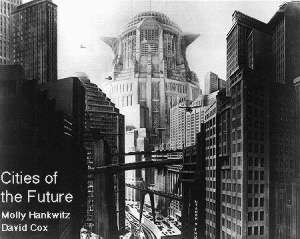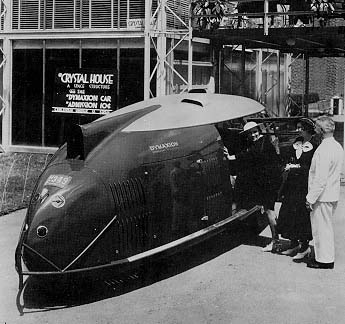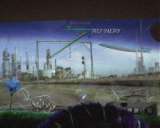
"Cities
of the Future 2000: V2.0"
by David Cox and Molly Hankwitz
Urban space today is a site of unparalelled change, alteration and dynamism. The impact of globalised systems of economic power, mediated by electronics, have lent the contemporary city a mutable aspect. Cities seem to seeth with the potential for self growth, grown organically from the material that is the media age. No-one it would seem has a strong handle on where contemporary cities are going. Gone are the heady days of certainty which thrust skyscrapers out of a landscape of mining and manufacturing. These are the fluid and liquid city days.
 We
are all makers of the landscape of
the imagination. Confronted by political
dissent, the powers that be are clinging
to models of urbanism which do not
fit those employed by often victorious
protestors. Against the physicality
of retail and point-of-sale, and the
protectionism of a trade focused idea
of the city as mall, is posited the
playful theatricality of popular protest,
connected by cellphone, uplinked to
the internet, sharing its anti-globalist
message with the world.
We
are all makers of the landscape of
the imagination. Confronted by political
dissent, the powers that be are clinging
to models of urbanism which do not
fit those employed by often victorious
protestors. Against the physicality
of retail and point-of-sale, and the
protectionism of a trade focused idea
of the city as mall, is posited the
playful theatricality of popular protest,
connected by cellphone, uplinked to
the internet, sharing its anti-globalist
message with the world.
A realtime, streaming-media, internet-mediated city is emerging from the ashes of the traditional industrial model. The very idea of the city is itself up for grabs. The recent protests in Seattle, Washington and Melbourne were battles in many ways for the very function of urban space itself. Against a trouble-free paradise for shoppers policed by men dressed like black tranformer robots, the protesters proposed a concept of the city as a site for popular expression and political celebration on a scale not seen for decades.
|
Cities of the Future Quicktime Samples David Cox (1.9 MB) Joe Gerhardt & Ruth Jarman (1.9 MB) |
It is communications and media technology which mediate these new often provisional spaces, the media of accessible camcorders,the internet and mobile phones as tools of organisation and mobilisation. The battle in Seattle and its recent Washington echo were partly struggles to attain a kind of 'city of the imagination' and a city of 'global liberty'. They are echoed in festival culture around the world, at provisional city events like "Burning Man", in squats and reclaimed spaces utilised by the rave and techno underground.
By ferrels, by artists, by culture jammers. reclaimed spaces utilised by the rave and techno underground. The quest for free space holds a special place in the popular imagination and has been depicted in different ways in many films over the years. Against the background of a tear gas and rubber bullet street conflict for the soul of the "real" city is a scrim of mainstream media sign making in the form of popular entertainment. In movies, and TV the contemporary screen city is a place where buildings can morph at will into transluscent jelly, can alter their physical dimensions in response to the emotions of those around them. These are cities which overlap seamlessly with the desires of their occupants. From New Babylon of the Situationists, through the 'plug-in' city of Archigram through to the architecture of contemporary urban protest - squats, share houses, artist collectives, micro cinemas, reclaimed land, altered and appropriated spaces. Here are new types of cities; bristling with cameras, obsessed with surveillance, power, and the absolute unquestionable soveriegnty of the affluent individual.
Films like "Contact", "Mission to Mars", "Falling Down", "Sliver", "Heat", "X-Men", and "The Matrix" depict structures and matter suffering a crisis of integrity. Computer graphics render solid surfaces transparent, fluid and mercurial. People in these spaces look at the world around them and their own bodies as completely made over. They are transformed for us by the changes around them, as we are by those around us. Flying cars are a reality today. Buildings made of foam and buildings made of information are now arguably as important as anything made out of concrete steel and glass. Soon buildings will be grown like plants.
New paradigms are needed for these cities of the future. Our architectural and design and cinematic present echoes a time prior when architects and designers were imagining a city of interchangable components alongside a constant climate of urban threat. Signage and billboards are programmable like computer screens, and every strategy of the streetwise is instantly appropriated by the commercial sector to target some new percieved demographic.
 The
ideas of contemporary designers and
writers in film, the internet and
new media are offering new insights
into what the city of the future might
be. And a corporate shell of clean
and affluent living is the farthest
thing from their minds. This is the
future. Here are the cities.
The
ideas of contemporary designers and
writers in film, the internet and
new media are offering new insights
into what the city of the future might
be. And a corporate shell of clean
and affluent living is the farthest
thing from their minds. This is the
future. Here are the cities.
Architect and Media critic Molly Hankwitz and film maker and academic David Cox present "Cities of the Future 2000" - a software upgrade to the hit show of 1999 with conceptual plugins and downloadable ideas for a wide range of media practitioners artists, and others who feel they'd like a stake in the look and feel of the streets around them.
Bringing you: Constant, Archigram, Debord, Lovink, Fuller, Bain, Cox, Wodiczko, MDVD, Independent Media Centre, Films: Contact, X-Men, Mission to Mars, Matrix, Archigram, Ads for Wireless, Heat, Falling Down, A Bout A Souffle, BIT, TRON, They Live!, Running Man, Robocop, Phantom Menace, Gladiator, Dreams May Come, Vertigo,

